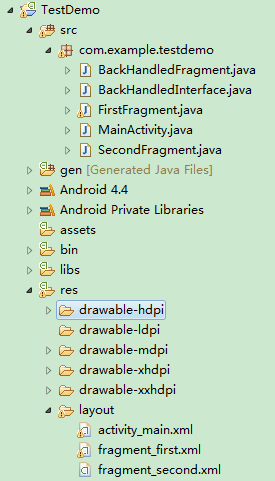
- Android中检查、设置默认程序详解
- Android组件TabHost实现页面中多个选项卡切换效果
- android ListView内数据的动态添加与删除实例代码
- Android实现截屏并保存操作功能
- Android UI设计系列之自定义ListView仿QQ空间阻尼下拉刷新和渐变菜单栏效果(8)
- Android应用中使用DOM方式解析XML格式数据的基本方法
- Android新功能曝光 或为5.1版且明年2月发
- Android clipChildren属性实例详解
- 安卓Android Context类实例详解
- 图解Eclipse在线安装ADT插件过程
- 另外两种Android沉浸式状态栏实现思路
- Android系统开发中log的使用方法及简单的原理
- Android基于Pull方式解析xml的方法详解
- 深入浅析Android手机卫士保存密码时进行md5加密
- Android执行shell命令详解
- APK程序获取system权限的方法
- Android实现button居中的方法
- Android控件系列之Shape使用方法
- 使用PHP开发Android应用程序技术介绍
- Android 将 android view 的位置设为右下角的解决方法
- android开发教程之间隔执行程序(android计时器)
- Android开发笔记之:ListView刷新顺序的问题详解
- android中开启actionbar的两种方法
- Android编程开发中ListView的常见用法分析
- 基于android样式与主题(style&theme)的详解
- 获取Android系统唯一识别码的方法
- Android应用程序的编译流程及使用Ant编译项目的攻略
- 导致adb无法启动的5种情况和解决方法
- 学习Android自定义Spinner适配器
- Android开发中Intent传递对象的方法分析
Android编程使用Fragment界面向下跳转并一级级返回的实现方法
本文实例讲述了Android编程使用Fragment界面向下跳转并一级级返回的实现方法。分享给大家供大家参考,具体如下:
1.首先贴上项目结构图:

2.先添加一个接口文件BackHandledInterface.java,定义一个setSelectedFragment方法用于设置当前加载的Fragment在栈顶,主界面MainActivity须实现此接口,代码如下:
package com.example.testdemo;
public interface BackHandledInterface {
public abstract void setSelectedFragment(BackHandledFragment selectedFragment);
}
3.定义一个抽象类BackHandledFragment继承自Fragment,后面跳转的Fragment界面都要继承自BackHandledFragment。抽象类BackHandledFragment中定义一个返回值为boolean类型的onBackPressed方法,用于处理点击返回按键(物理Back键)时的逻辑,若该方法返回false,表示当前Fragment不消费返回事件,而由Fragment所属的FragmentActivity来处理这个事件。代码如下:
package com.example.testdemo;
import android.os.Bundle;
import android.support.v4.app.Fragment;
public abstract class BackHandledFragment extends Fragment {
protected BackHandledInterface mBackHandledInterface;
/**
* 所有继承BackHandledFragment的子类都将在这个方法中实现物理Back键按下后的逻辑
*/
protected abstract boolean onBackPressed();
@Override
public void onCreate(Bundle savedInstanceState) {
super.onCreate(savedInstanceState);
if (!(getActivity() instanceof BackHandledInterface)) {
throw new ClassCastException(
"Hosting Activity must implement BackHandledInterface");
} else {
this.mBackHandledInterface = (BackHandledInterface) getActivity();
}
}
@Override
public void onStart() {
super.onStart();
// 告诉FragmentActivity,当前Fragment在栈顶
mBackHandledInterface.setSelectedFragment(this);
}
}
4.主界面MainActivity要继承FragmentActivity才能调用getSupportFragmentManager()方法来处理Fragment。MainActivity还需重写onBackPressed方法用来捕捉返回键(Back Key)事件,代码如下:
package com.example.testdemo;
import android.os.Bundle;
import android.support.v4.app.FragmentActivity;
import android.support.v4.app.FragmentManager;
import android.support.v4.app.FragmentTransaction;
import android.view.View;
import android.view.View.OnClickListener;
import android.widget.Button;
public class MainActivity extends FragmentActivity implements
BackHandledInterface {
private static MainActivity mInstance;
private BackHandledFragment mBackHandedFragment;
private Button btnSecond;
@Override
public void onCreate(Bundle savedInstanceState) {
super.onCreate(savedInstanceState);
setContentView(R.layout.activity_main);
btnSecond = (Button) findViewById(R.id.btnSecond);
btnSecond.setOnClickListener(new OnClickListener() {
@Override
public void onClick(View v) {
FirstFragment first = new FirstFragment();
loadFragment(first);
btnSecond.setVisibility(View.GONE);
}
});
}
public static MainActivity getInstance() {
if (mInstance == null) {
mInstance = new MainActivity();
}
return mInstance;
}
public void loadFragment(BackHandledFragment fragment) {
BackHandledFragment second = fragment;
FragmentManager fm = getSupportFragmentManager();
FragmentTransaction ft = fm.beginTransaction();
ft.replace(R.id.firstFragment, second, "other");
ft.addToBackStack("tag");
ft.commit();
}
@Override
public void setSelectedFragment(BackHandledFragment selectedFragment) {
this.mBackHandedFragment = selectedFragment;
}
@Override
public void onBackPressed() {
if (mBackHandedFragment == null || !mBackHandedFragment.onBackPressed()) {
if (getSupportFragmentManager().getBackStackEntryCount() == 0) {
super.onBackPressed();
} else {
if (getSupportFragmentManager().getBackStackEntryCount() == 1) {
btnSecond.setVisibility(View.VISIBLE);
}
getSupportFragmentManager().popBackStack();
}
}
}
}
5.分别添加两个子级Fragment,FirstFragment.java和SecondFragment.java,代码分别如下:
FirstFragment.java:
package com.example.testdemo;
import android.os.Bundle;
import android.support.annotation.Nullable;
import android.support.v4.app.FragmentManager;
import android.support.v4.app.FragmentTransaction;
import android.view.LayoutInflater;
import android.view.View;
import android.view.View.OnClickListener;
import android.view.ViewGroup;
import android.widget.Button;
public class FirstFragment extends BackHandledFragment {
private View myView;
private Button btnSecond;
@Override
public View onCreateView(LayoutInflater inflater,
@Nullable ViewGroup container, @Nullable Bundle savedInstanceState) {
myView = inflater.inflate(R.layout.fragment_first, null);
initView();
return myView;
}
private void initView() {
btnSecond = (Button) myView.findViewById(R.id.btnSecond);
btnSecond.setOnClickListener(new OnClickListener() {
@Override
public void onClick(View v) {
SecondFragment second = new SecondFragment();
FragmentManager fm = getFragmentManager();
FragmentTransaction ft = fm.beginTransaction();
ft.replace(R.id.firstFragment, second);
ft.addToBackStack("tag");
ft.commit();
}
});
}
@Override
protected boolean onBackPressed() {
return false;
}
}
SecondFragment.java:
package com.example.testdemo;
import android.os.Bundle;
import android.support.annotation.Nullable;
import android.view.LayoutInflater;
import android.view.View;
import android.view.ViewGroup;
public class SecondFragment extends BackHandledFragment {
private View mView;
@Override
public View onCreateView(LayoutInflater inflater,
@Nullable ViewGroup container, @Nullable Bundle savedInstanceState) {
mView = inflater.inflate(R.layout.fragment_second, null);
return mView;
}
@Override
protected boolean onBackPressed() {
return false;
}
}
6.三个布局文件代码如下:
activity_main.xml:
<RelativeLayout xmlns:android="http://schemas.android.com/apk/res/android"
xmlns:tools="http://schemas.android.com/tools"
android:layout_width="match_parent"
android:layout_height="match_parent"
android:orientation="vertical" >
<TextView
android:layout_width="wrap_content"
android:layout_height="wrap_content"
android:layout_centerInParent="true"
android:text="FragmentActivity 父界面"
android:textSize="26sp" />
<Button
android:id="@+id/btnSecond"
android:layout_width="wrap_content"
android:layout_height="wrap_content"
android:layout_alignParentBottom="true"
android:text="跳转到FirstFragment" />
<FrameLayout
android:id="@+id/firstFragment"
android:layout_width="match_parent"
android:layout_height="match_parent" >
</FrameLayout>
</RelativeLayout>
fragment_first.xml:
<?xml version="1.0" encoding="utf-8"?>
<RelativeLayout xmlns:android="http://schemas.android.com/apk/res/android"
android:layout_width="match_parent"
android:layout_height="match_parent"
android:background="#e5e5e5"
android:orientation="vertical" >
<TextView
android:layout_width="wrap_content"
android:layout_height="wrap_content"
android:layout_centerInParent="true"
android:text="FirstFragment"
android:textColor="#000000"
android:textSize="26sp" />
<Button
android:id="@+id/btnSecond"
android:layout_width="wrap_content"
android:layout_height="wrap_content"
android:layout_alignParentBottom="true"
android:text="打开SecondFragment" />
</RelativeLayout>
fragment_second.xml:
<?xml version="1.0" encoding="utf-8"?>
<RelativeLayout xmlns:android="http://schemas.android.com/apk/res/android"
android:layout_width="match_parent"
android:layout_height="match_parent"
android:background="#e5e5e5"
android:orientation="vertical" >
<TextView
android:layout_width="wrap_content"
android:layout_height="wrap_content"
android:layout_centerInParent="true"
android:text="SecondFragment"
android:textColor="#000000"
android:textSize="26sp" />
</RelativeLayout>
7.最后奉上实例链接:
完整实例代码代码点击此处本站下载。
希望本文所述对大家Android程序设计有所帮助。
- 上一篇文章: Android编程单击图片实现切换效果的方法
- 下一篇文章: Android应用开发之简易、大气音乐播放器实现专辑倒影效果
- Android实现ListView分页自动加载数据的方法
- Android根据电话号码获得联系人头像实例代码
- Android获取屏幕方向及键盘状态的小例子
- vbs打开ie两种方法 在VBScript中启动IE浏览
- Android中监听软键盘显示状态实现代码
- ubuntu 12.10 上 android 编译环境搭建的深
- Android实现Activity之间通信的方法